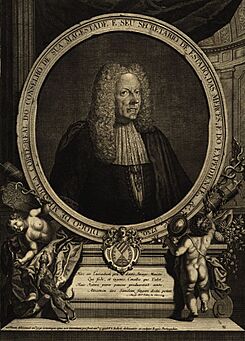Diogo de Mendonça Corte-Real facts for kids
Quick facts for kids
Diogo de Mendonça Corte-Real
KC FC
|
|
|---|---|
 |
|
| Secretary of State of Portugal | |
| In office 24 September 1704 – 9 May 1736 |
|
| Monarch | Peter II John V |
| Preceded by | Manuel Pereira |
| Succeeded by | João da Mota e Silva |
| Personal details | |
| Born | 17 July 1658 Tavira, Algarve, Portugal |
| Died | 9 May 1736 (aged 77) Benfica, Lisbon, Portugal |
| Alma mater | University of Coimbra |
| Profession | Statesman, Diplomat |
| Signature | |
Diogo de Mendonça Corte-Real (born June 17, 1658 – died May 9, 1736) was an important Portuguese diplomat and statesman. A diplomat is someone who represents their country in other nations. A statesman is a skilled and respected leader in government. Diogo served as the Secretary of State for two kings: King Peter II and King John V.
Who Was Diogo de Mendonça Corte-Real?
Diogo de Mendonça Corte-Real was born in 1658 in Tavira, Portugal. His parents, also named Diogo de Mendonça Corte-Real and Jerónima de Lacerda, came from noble families. These families had connections to important noble houses in both Portugal and Spain.
Diogo showed great intelligence from a young age. He went to the University of Coimbra. There, he earned degrees in law in 1686 and 1687. After finishing his studies, he became a chief judge in the Porto area. People liked him because he was fair and had a good character.
His skills as a judge caught the attention of the Royal Court and King Peter II. In 1691, the King asked him to become a special diplomat. His mission was to go to the Dutch Republic (modern-day Netherlands). He needed to solve problems caused by the Dutch navy attacking Portuguese ships.
Diogo's Diplomatic Adventures
On March 3, 1691, Diogo set sail for the Dutch Republic. During the journey, his ship hit a sandbank near the coast of England. Everyone on board panicked, but Diogo stayed calm. He helped the officers manage the evacuation.
Diogo, his family, and the captain left the ship in one boat. The rest of the crew used another boat. The ship sank. The two boats drifted all night until they saw the English coastline in the morning. Diogo then traveled to London and from there, he went to The Hague in the Dutch Republic.
Diogo de Mendonça Corte-Real was very good at handling the issues between Portugal and the Dutch Republic. After many meetings, he achieved his goal on May 22, 1692. The two nations signed a treaty. In this agreement, the Dutch Republic paid a large sum of money (eighty-thousand patacas). This was to make up for all the attacks on Portuguese ships.
This successful mission greatly impressed the Portuguese King. King Peter II then decided Diogo was the right person for another important job. In 1693, he sent Diogo as an envoy to the Spanish Court. Diogo stayed in Spain until 1703. He returned to Portugal because King Charles II of Spain died. This event led to the start of the Spanish War of Succession.
On April 2, 1701, King Peter II gave Diogo another role. He became the Secretário Real das Mercês e do Expediente. His duties included handling decrees, orders, and letters that were not top-level state matters. He also managed "mercies," which were payments for services to the State and Crown. When Portugal joined the Spanish War of Succession, Diogo was in charge of managing military operations. Later, he helped with the talks that led to the Treaty of Utrecht. This treaty finally ended the conflict.
Serving as Secretary of State
King Peter II passed away on December 9, 1706. His son, King John V, became the new king. On April 27, 1707, King John V appointed Diogo de Mendonça Corte-Real as his Secretário de Estado. This position was similar to what we call a Prime Minister today.
As Secretary of State, Diogo handled important royal matters. For example, he managed the marriage agreements for Prince Joseph of Portugal. Joseph was to marry Mariana Victoria, a Spanish princess. Diogo also arranged the marriage between Prince D. Ferdinand of Spain and the Portuguese princess Barbara of Portugal.
Diogo de Mendonça Corte-Real married D. Teresa de Bourbon in October 1718. She was a widow. They had a daughter, D. Joaquina de Bourbon, who was baptized by a Cardinal. Their first son, João Pedro de Mendonça Corte-Real, had King John V as his godfather.
Diogo was very active in his role and served until his death on May 9, 1736. He was walking on his farm in Benfica, Lisbon, when he suddenly felt a sharp pain. He died within a few hours. His body was buried in the Church of Nossa Senhora do Amparo.

